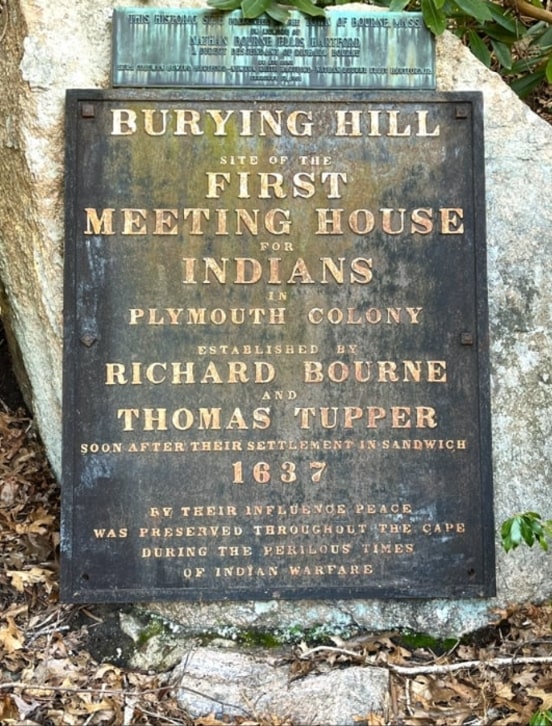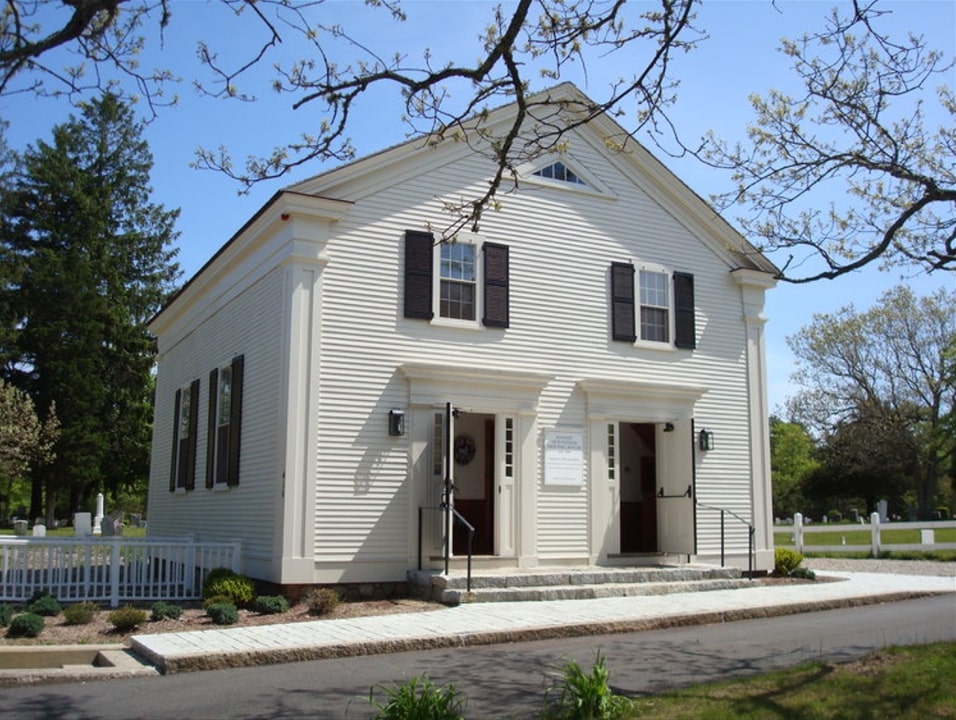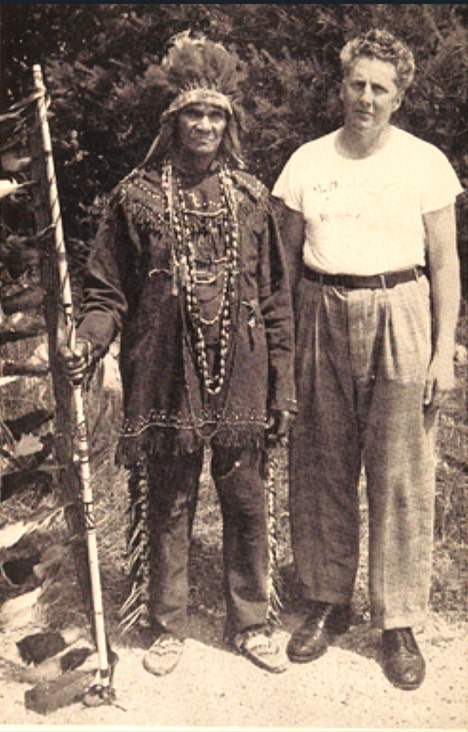Introduction: In this article, Melissa Davenport Berry writes about Richard Bourne, a missionary to the Mashpee Wampanoag Tribe in the Plymouth Colony. Melissa is a genealogist who has a website, americana-archives.com, and a Facebook group, New England Family Genealogy and History.
In my next two articles, I cover two important historical figures in the early settlement of Plymouth Colony: Richard Bourne (today) and Thomas Tupper (Friday), missionaries devoted to the Native American Indians.

This marker reads:
Burying Hill, site of the first meeting house for Indians in Plymouth Colony, established by Richard Bourne and Thomas Tupper soon after their settlement in Sandwich, 1637. By their influence, peace was preserved throughout the Cape during the perilous times of Indian warfare.
My research began a while ago when Katie Crocker of Barnstable, Massachusetts, asked me to look into her 10th great grandfather Richard Bourne.
A few of Katie’s ancestors married into the Bourne family. Katie’s 5th great grandfather Zenas Crocker, son of Ebenezer Jr. and Zerviah (Winslow) Crocker, married Hannah Bourne, daughter of Melatiah and Mary (Howes) Bourne.
An account book that belonged to Zenas Crocker and his family, covering the years 1790 through 1843, contains entries of the residents and members of the Mashpee (originally called Marshpee) Wampanoag Tribe. You can read more about this in the links at the end of this article.
Richard Bourne, aka “the White Sachem” or “Little Father,” a missionary that the town of Bourne, Massachusetts, is named for, helped secure the Mashpee reservation land and a meeting house for the Indians. He mastered their language and taught them to read and write in both their native tongue and English.
The publication “Genealogical Notes of Barnstable Families: Being a Reprint of the Amos Otis Papers, Originally Published in the Barnstable Patriot” references Bourne’s role in the preservation of Indian land. It reads:
At the solicitation of Mr. Bourne, the tract of land at South Sea, containing about 10,500 acres, and known as the plantation of Marshpee, was reserved by grant from the Colony to the South Sea Indians.
The late Rev. Mr. Hawley of Marshpee, says, ‘‘Mr. Bourne was a man of that discernment that he considered it as vain to propagate Christian knowledge among any people without a territory where they might remain in peace, from generation to generation, and not be ousted.”
Every year the Old Indian Meeting House located in Mashpee has a Richard Bourne Day. It is an annual service held in partnership with the Mashpee Baptist Church and citizens of the Mashpee Wampanoag Tribe.

In his book A Pilgrim Returns to Cape Cod, historian Edward Rowe Snow further cites Amos Otis on the character and contribution of Richard Bourne:
We can best appreciate what Richard Bourne meant to Cape Cod and its Indians by quoting from the words of antiquarian Amos Otis, who said that “Richard Bourne, by his unremitted labors for seventeen years, made friends of a sufficient number of Indians, naturally hostile to the English, to turn the scales in Plymouth County and give the preponderance to the whites… Bourne did more, by the moral power which he exerted, to defend the old colony, than Bradford did at the head of his army. Laurel wreaths shade the brows of military heroes, their names are enshrined in a bright halo of glory, while the man who has done as good service for his country, by moral means, sinks into comparative insignificance and is too often forgotten.”
Here is a photo of Edward Rowe Snow with Ambrose Pells (aka Chief Rain-in-the-Face), the backbone of the Mashpee Tribe during his life. He was a fisherman and natural Indian man, proud of his heritage, who was always busy caring for the Old Indian Church.

There is a fun anecdote associated with Richard Bourne that many descendants may enjoy. It appeared in the food section of the Plain Dealer, under the heading “Cranberries – From Myth to Nation’s Holiday Fruit,” and it is fitting for the coming season.

This article reports:
Cranberries, like blueberries and Concord grapes, are native Americans. The tart crimson fruit began growing in Massachusetts, according to legend, because of a disagreement between a medicine man and a settler.
The Indian cast a spell on the Rev. Richard Bourne, miring him in quicksand, then challenged him to a 15-day battle of wits. Bourne would have succumbed to hunger and thirst were it not for a white dove that appeared from time to time to feed him succulent red berries. Bourne outlasted the medicine man. And during the marathon, one berry fell to the ground and took root.
Next up: Richard Tupper.
Explore over 330 years of newspapers and historical records in GenealogyBank. Discover your family story! Start a 7-Day Free Trial
Note on the header image: Oakes Agnus Coombs Jr. and his wife Amanda Pocknett, daughter of Nathan Pocknett and Eleanor Hicks. She was the widow of Thomas William Gardner. These photos were featured in the 125th Anniversary of Mashpee Celebration 1995. Credit: Town of Mashpee, Massachusetts, Archives.
Related Articles:
- Mayflower Descendants: Who’s Who, Part 35 (part 9)
- Mayflower Descendants: Who’s Who, Part 35 (part 10)
- Mayflower Descendants: Who’s Who, Part 35 (part 11)
- Mayflower Descendants: Who’s Who, Part 35 (part 12)
- Mayflower Descendants & the Mashpee Wampanoag Tribe (part 1)
- Mayflower Descendants & the Mashpee Wampanoag Tribe (part 2)
- Mayflower Descendants & the Mashpee Wampanoag Tribe (part 3)
